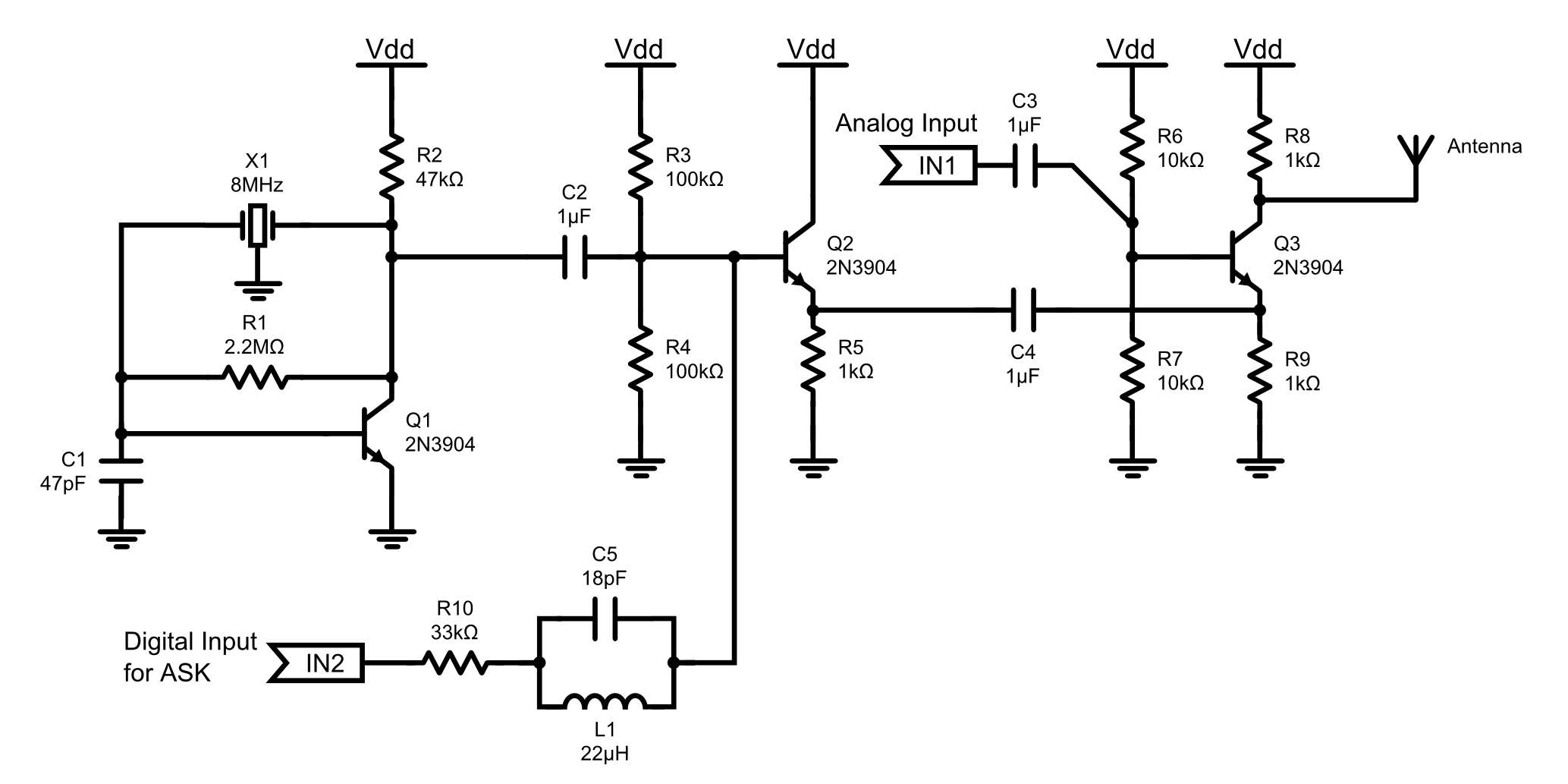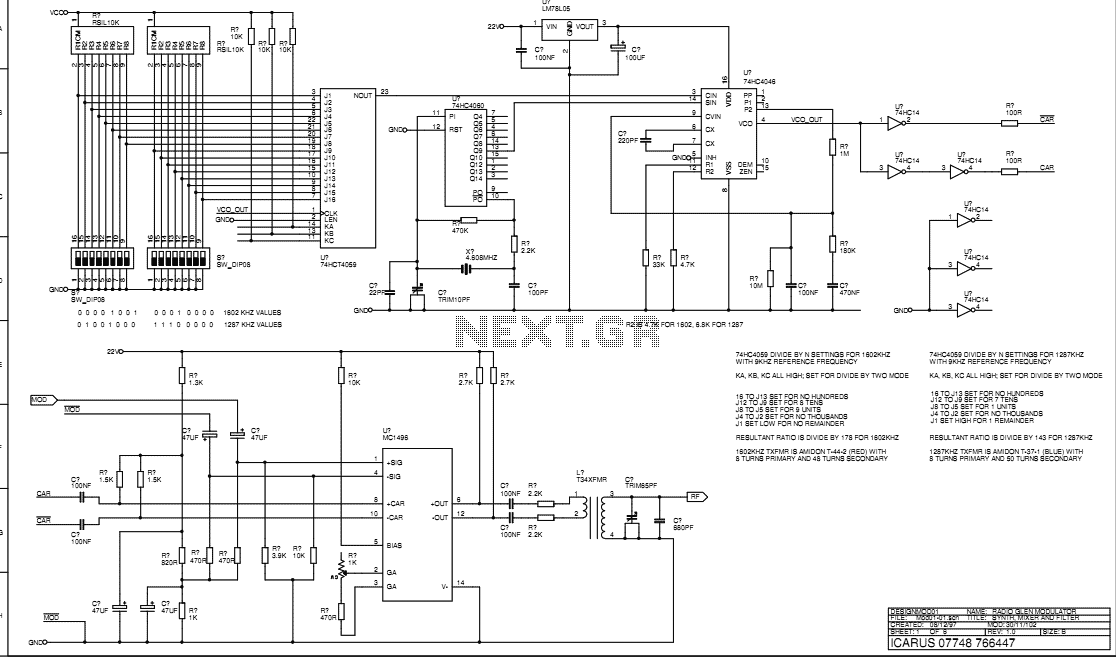
1.5V Tracking Transmitter

This circuit allows for the construction of a compact tracking transmitter that can be detected using an FM broadcast band radio receiver. The transmitter operates on a power source of any 1.5V battery or power supply. It has a transmission range of up to 1 mile, which is influenced by factors such as battery voltage, height above ground, receiver sensitivity, and antenna length. Under optimal conditions, distances of up to 1 mile have been reported. It is advisable to use this transmitter with FM radios that offer continuous tuning across the dial. The performance of the transmitter improves with a high-quality receiver and antenna system; however, satisfactory operation can still be achieved with basic radios and the standard telescoping antenna that comes with most devices.
The circuit design for the tracking transmitter typically includes a few essential components: an oscillator, modulator, and an output stage. The oscillator generates a radio frequency signal, which is modulated with the audio or data signal to be transmitted. This modulation can be achieved using simple components such as a transistor or an integrated circuit designed for RF applications.
The choice of components greatly influences the overall performance of the transmitter. For instance, using a low-noise transistor in the oscillator stage can improve the signal quality, thereby extending the range. The antenna design is also crucial; a simple quarter-wave dipole antenna can be effective for this application. The length of the antenna should be calculated based on the frequency of operation, ensuring it is tuned for optimal performance.
The power supply should be stable to maintain consistent transmission. A 1.5V alkaline or lithium battery is often sufficient, but using a rechargeable battery can provide longer operational time, especially for extended tracking applications. It is also important to consider the placement of the transmitter; mounting it at a higher elevation can significantly enhance the line-of-sight transmission, thereby increasing the effective range.
In conclusion, while the circuit can function with minimal components, careful selection and arrangement of parts, along with proper tuning and placement, can lead to superior performance and extended range for tracking purposes. Users should also ensure compliance with local regulations regarding the use of radio frequencies to avoid interference with licensed broadcasts.With this circuit you can build a very small tracking transmitter that can be tracked using a FM broadcast band radio receiver. The transmitter can be powered from any 1.5V volt battery or power supply. Transmitter has a range up to 1 mile depending on battery voltage, height above ground, receiver sensitivity, and antenna length.
Under certain conditions distances of 1 mile have been achieved. It is recommended that this transmitter be used with FM radios that can tune continuously across the dial. The better the receiver and receiver antenna system the greater the practical range of the transmitter, however good functionality can be achieved with the least expensive radios and using only the standard telescoping antenna included with most radios.
. 🔗 External reference
The circuit design for the tracking transmitter typically includes a few essential components: an oscillator, modulator, and an output stage. The oscillator generates a radio frequency signal, which is modulated with the audio or data signal to be transmitted. This modulation can be achieved using simple components such as a transistor or an integrated circuit designed for RF applications.
The choice of components greatly influences the overall performance of the transmitter. For instance, using a low-noise transistor in the oscillator stage can improve the signal quality, thereby extending the range. The antenna design is also crucial; a simple quarter-wave dipole antenna can be effective for this application. The length of the antenna should be calculated based on the frequency of operation, ensuring it is tuned for optimal performance.
The power supply should be stable to maintain consistent transmission. A 1.5V alkaline or lithium battery is often sufficient, but using a rechargeable battery can provide longer operational time, especially for extended tracking applications. It is also important to consider the placement of the transmitter; mounting it at a higher elevation can significantly enhance the line-of-sight transmission, thereby increasing the effective range.
In conclusion, while the circuit can function with minimal components, careful selection and arrangement of parts, along with proper tuning and placement, can lead to superior performance and extended range for tracking purposes. Users should also ensure compliance with local regulations regarding the use of radio frequencies to avoid interference with licensed broadcasts.With this circuit you can build a very small tracking transmitter that can be tracked using a FM broadcast band radio receiver. The transmitter can be powered from any 1.5V volt battery or power supply. Transmitter has a range up to 1 mile depending on battery voltage, height above ground, receiver sensitivity, and antenna length.
Under certain conditions distances of 1 mile have been achieved. It is recommended that this transmitter be used with FM radios that can tune continuously across the dial. The better the receiver and receiver antenna system the greater the practical range of the transmitter, however good functionality can be achieved with the least expensive radios and using only the standard telescoping antenna included with most radios.
. 🔗 External reference





